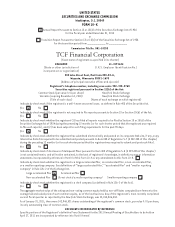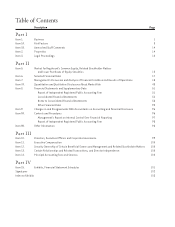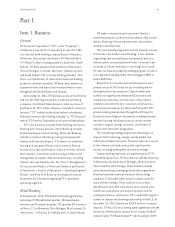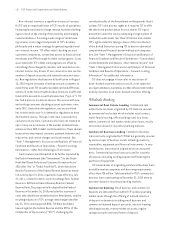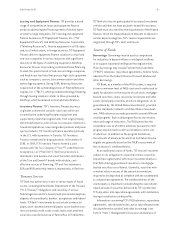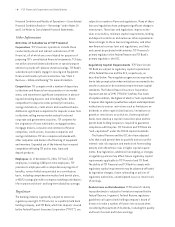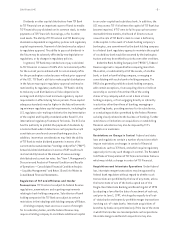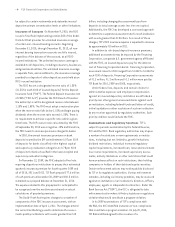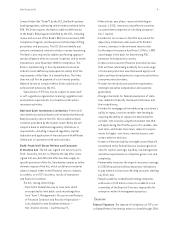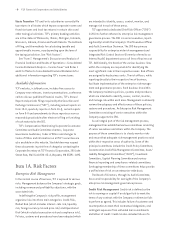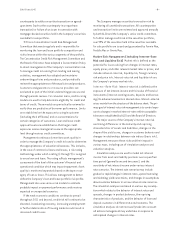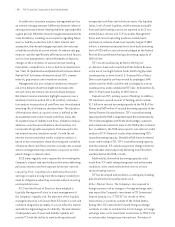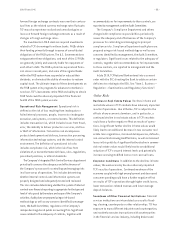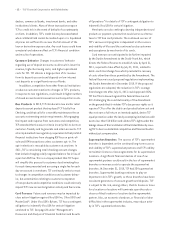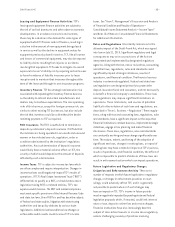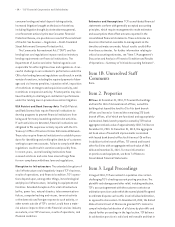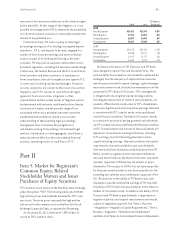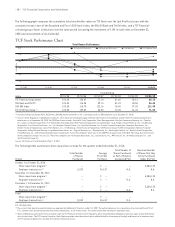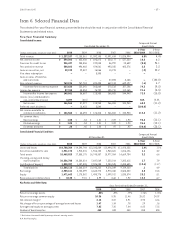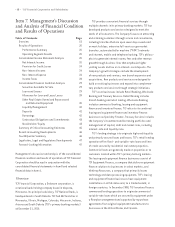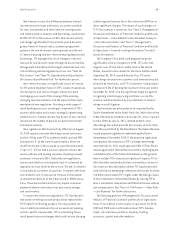TCF Bank 2010 Annual Report Download - page 25
Download and view the complete annual report
Please find page 25 of the 2010 TCF Bank annual report below. You can navigate through the pages in the report by either clicking on the pages listed below, or by using the keyword search tool below to find specific information within the annual report.• 9 •
2010 Form 10-K
counterparty to settle a securities transaction on agreed-
upon terms (such as the counterparty in a repurchase
transaction) or failure of an issuer in connection with
mortgage-backed securities held in the Company’s securities
available for sale portfolio.
TCF has a Concentration Credit Risk Management
Committee that meets regularly and is responsible for
monitoring the loan and lease portfolio composition and
risk tolerance within the various segments of the portfolio.
The Concentration Credit Risk Management Committee and
the Board of Directors have adopted a Concentration Policy
to direct management of the Company’s concentration risk.
To manage credit risk arising from lending and leasing
activities, management has adopted and maintains
underwriting policies and procedures, and periodically
reviews the appropriateness of these policies and procedures.
Customers and guarantors or recourse providers are
evaluated as part of the initial underwriting processes and
through periodic reviews. For consumer loans, credit scoring
models are used to help determine eligibility for credit and
terms of credit. These models are periodically reviewed to
verify they are predictive of borrower performance. Limits
are established on the exposure to a single customer
(including their affiliates) and on concentrations for
certain categories of customers. Loan and lease credit
approval levels are established so that larger credit
exposures receive managerial review at the appropriate
level through various credit committees.
Management continuously monitors asset quality in
order to manage the Company’s credit risk and to determine
the appropriateness of valuation allowances. This includes,
in the case of commercial loans and leases, a risk rating
methodology under which a rating (1 through 9) is assigned
to every loan and lease. The rating reflects management’s
assessment of the level of the customer’s financial and
operational condition which may impact repayment. Asset
quality is monitored separately based on the type or cat-
egory of loan or lease. This allows management to better
define the Company’s loan and lease portfolio risk profile.
Management also uses various risk models to estimate
probable impact on payment performance under various
expected or unexpected scenarios.
If the weak economic conditions continue to prevail
throughout 2011 and beyond, credit risk will continue to be
elevated. A weakening economy, increasing unemployment
or further deterioration of housing markets could result in
increased credit losses.
The Company manages securities transaction risk by
monitoring all unsettled transactions. All counterparties
and transaction limits are reviewed and approved annually
by both ALCO and the Company’s senior credit committee.
To further manage credit risk in the securities portfolio,
over 99% of the securities held in the securities available
for sale portfolio are issued and guaranteed by Fannie Mae,
Freddie Mac or Ginnie Mae.
Market Risk Management (Including Interest-Rate
Risk and Liquidity Risk) Market risk is defined as the
potential for losses arising from changes in interest rates,
equity prices, and other relevant market rates or prices, and
includes interest-rate risk, liquidity risk, foreign currency
risk and price risk. Interest-rate risk and liquidity risk are
the Company’s primary market risks.
Interest-Rate Risk Interest-rate risk is defined as the
exposure of net interest income and fair value of financial
instruments (interest-earning assets, deposits and borrow-
ings) to adverse movements in interest rates. Interest-rate risk
arises mainly from the structure of the balance sheet. The pri-
mary goal of interest-rate risk management is to control expo-
sure to changes in market interest-rates within acceptable
tolerances established by ALCO and the Board of Directors.
The major sources of the Company’s interest-rate risk
are timing differences in the maturity and repricing
characteristics of assets and liabilities, changes in the
shape of the yield curve, changes in customer behavior and
changes in relationships between rate indices (basis risk).
Management measures these risks and their impact in
various ways, including use of simulation analyses and
valuation analyses.
Simulation analyses are used to model net interest
income from asset and liability positions over a specified
time period (generally one and two years), and the
sensitivity of net interest income under various interest
rate scenarios. The interest rate scenarios may include
gradual or rapid changes in interest rates, spread narrowing
and widening, yield curve twists, and changes in assumptions
about customer behavior in various interest rate scenarios.
The simulation analyses are based on various key assump-
tions which relate to the behavior of interest rates and
spreads, changes in product balances, the repricing
characteristics of products, and the behavior of loan and
deposit customers in different rate environments. The
simulation analyses do not necessarily take into account
all actions management may undertake in response to
anticipated changes in interest rates.


